List of politicians of Chinese descent
This is a list of former and current politicians outside of the Greater China region who were/are of partial or full Chinese descent.
Heads of state and heads of government
This is a list of non-monarchical heads of state and heads of government—including main, deputy and acting office holders—outside of Greater China of partial or full Chinese heritage. Entries are sorted according to dates of assumption of office.
| Name[lower-alpha 1] | Portrait | Polity | Office | Tenure | Ref. |
|---|---|---|---|---|---|
| Luo Fangbo 羅芳伯 |
Lanfang Republic | President (Head of state & head of government) |
1777–1795 | ||
| Jiang Wubo 江戊伯 |
Lanfang Republic | President (Head of state & head of government) |
1795–1799, 1804–1811 |
||
| Que Sibo 闕四伯 |
Lanfang Republic | President (Head of state & head of government) |
1799–1804 | ||
| Song Chabo 宋插伯 |
Lanfang Republic | President (Head of state & head of government) |
1811–1823 | ||
| Liu Tai'er 劉台二 |
Lanfang Republic | President (Head of state & head of government) |
1823–1838 | ||
| Gu Liubo 古六伯 |
Lanfang Republic | President (Head of state & head of government) |
1838–1842 | ||
| Xie Guifang 謝桂芳 |
Lanfang Republic | President (Head of state & head of government) |
1842–1843 | ||
| Ye Tenghui 葉騰輝 |
Lanfang Republic | President (Head of state & head of government) |
1843–1845 | ||
| Liu Qianxing 劉乾興 |
Lanfang Republic | President (Head of state & head of government) |
1845–1848 | ||
| Liu Asheng 劉阿生 |
Lanfang Republic | President (Head of state & head of government) |
1848–1876, 1880–1884 |
||
| Liu Liangguan 劉亮官 |
Lanfang Republic | President (Head of state & head of government) |
1876–1880 | ||
| Emilio Aguinaldo 埃米利奧·阿奎納多 |
.jpg.webp) |
President (Head of state) |
1899–1901 | [1] | |
| Pedro Paterno 佩德羅·帕特諾 |
 |
Prime Minister (Head of government) |
1899 | [2] | |
| Phraya Manopakorn Nititada 披耶·瑪奴巴功 |
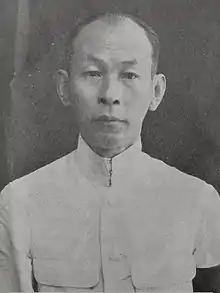 |
Prime Minister (Head of government) |
1932–1933 | [3] | |
| Phraya Phahonphonphayuhasena 披耶帕鳳·豐派育哈色納 |
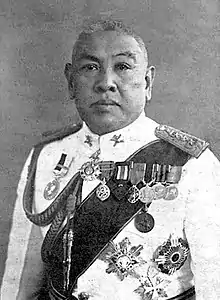 |
Prime Minister (Head of government) |
1933–1938 | [4][5] | |
| Manuel L. Quezon 曼努埃爾·奎松 |
.jpg.webp) |
President (Head of state & head of government) |
1935–1944 | [6] | |
| Sergio Osmeña 塞爾吉奧·奧斯梅尼亞 |
 |
Vice President (Deputy head of state & deputy head of government) |
1935–1944 | [7] | |
| President (Head of state & head of government) |
1944–1946 | ||||
| Plaek Phibunsongkhram 貝·鑾披汶頌堪 |
 |
Prime Minister (Head of government) |
1938–1944, 1948–1957 |
[8] | |
| Fulgencio Batista 富爾亨西奧·巴蒂斯塔 |
 |
President (Head of state) |
1940–1944, 1952–1959 |
[9][10][11] | |
| Khuang Aphaiwong 寬·阿派旺 |
 |
Prime Minister (Head of government) |
1944–1945, 1946, 1947–1948 |
[12] | |
| Son Ngoc Thanh 山玉成 |
Prime Minister (Head of government) |
1945, 1972 |
[13] | ||
| Thawi Bunyaket 他威·汶耶革 |
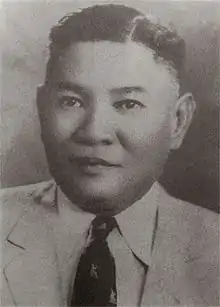 |
Prime Minister (Head of government) |
1945 | ||
| Seni Pramoj 社尼·巴莫 |
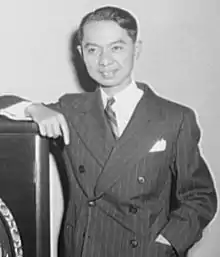 |
Prime Minister (Head of government) |
1945–1946, 1975, 1976 |
[14] | |
| Pridi Banomyong 比里·帕儂榮 |
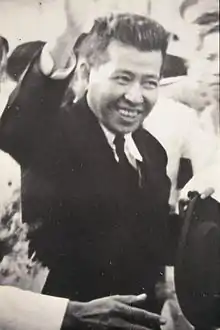 |
Prime Minister (Head of government) |
1946 | [15][16] | |
| Thawan Thamrongnawasawat 鑾探隆·那瓦沙瓦 |
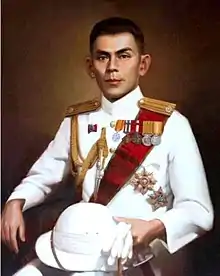 |
Prime Minister (Head of government) |
1946–1947 | [17][18] | |
| Syngman Rhee 李承晚 |
 |
President (Head of state & head of government) |
1948–1960 | [19] | |
| Lee Beom-seok 李範奭 |
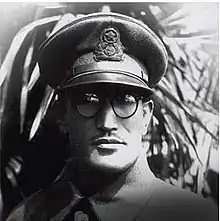 |
Prime Minister (Deputy head of government) |
1948–1950 | [20] | |
| Fernando Lopez 費爾南多·洛佩斯 |
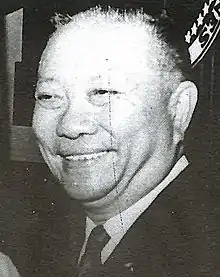 |
Vice President (Deputy head of state & deputy head of government) |
1949–1953, 1965–1972 |
[21] | |
| Lim Yew Hock 林有福 |
Chief Minister (Head of government) |
1956–1959 | [22] | ||
| Pote Sarasin 乃朴·沙拉信 |
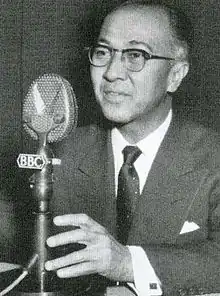 |
Prime Minister (Head of government) |
1957 | [23] | |
| Thanom Kittikachorn 他儂·吉滴卡宗 |
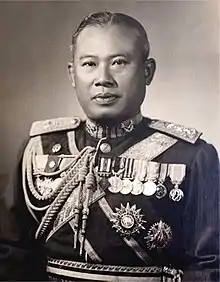 |
Prime Minister (Head of government) |
1958, 1963–1973 |
[24] | |
| Ne Win 奈溫 |
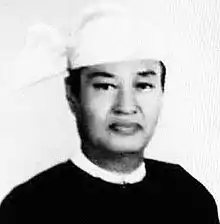 |
Prime Minister (Head of government) |
1958–1960 | [25] | |
| Chairman (Head of state) |
1962–1974 | ||||
| President (Head of state) |
1974–1981 | ||||
| Sarit Thanarat 沙立·他那叻 |
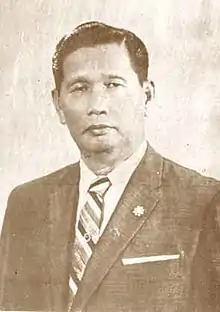 |
Prime Minister (Head of government) |
1959–1963 | [26][27][28] | |
| Toh Chin Chye 杜進才 |
Deputy Prime Minister (Deputy head of government) |
1959–1968 | [29] | ||
| Lee Kuan Yew 李光耀 |
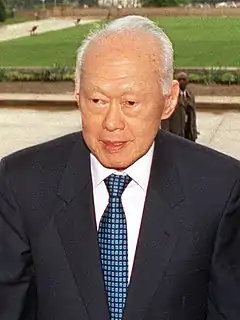 |
Prime Minister (Head of government) |
1959–1990 | [30][31] | |
| Nhiek Tioulong 涅刁龍 |
 |
Prime Minister (acting) (Head of government) |
1962 | ||
| Ferdinand Marcos 費迪南德·馬科斯 |
.JPEG.webp) |
President (Head of state & head of government) |
1965–1986 | [1][32][33][34] | |
| Prime Minister (Head of government) |
1978–1981 | ||||
| Lon Nol 朗諾 |
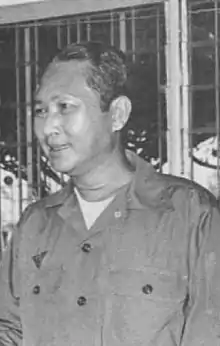 |
Prime Minister (Head of government) |
1966–1967, 1969–1971 |
[35] | |
| President (Head of state) |
1972–1975 | ||||
| Arthur Chung 鍾亞瑟 |
 |
President (Head of state & head of government) |
1970–1980 | [36][37] | |
| Ismail Abdul Rahman 依斯邁·阿都·拉曼 |
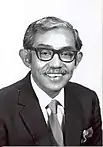 |
Deputy Prime Minister (Deputy head of government) |
1970–1973 | [38] | |
| Cheng Heng 鄭興 |
Chief of State (acting) (Head of state) |
1970 | [39] | ||
| President (Head of state) |
1970–1972 | ||||
| Goh Keng Swee 吳慶瑞 |
Deputy Prime Minister (Deputy head of government) |
1973–1985 | [40] | ||
| Sanya Dharmasakti 訕耶·探瑪塞 |
.jpg.webp) |
Prime Minister (Head of government) |
1973–1975 | ||
| Kukrit Pramoj 克立·巴莫 |
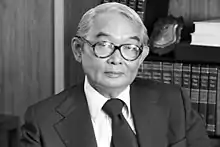 |
Prime Minister (Head of government) |
1975–1976 | [14] | |
| Khieu Samphan 喬森潘 |
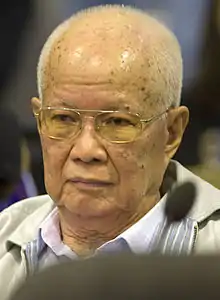 |
Prime Minister (acting) (Head of government) |
1976 | [41][42] | |
| Chairman (Head of state) |
1976–1979 | ||||
| Pol Pot 波爾布特 |
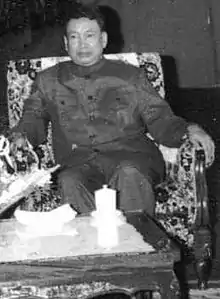 |
Prime Minister (Head of government) |
1976, 1976–1979 |
[43] | |
| Ieng Sary 英薩利 |
 |
Deputy Prime Minister (Deputy head of government) |
1976–1979 | [44][45][46] | |
| James Mancham 詹姆斯·曼卡姆 |
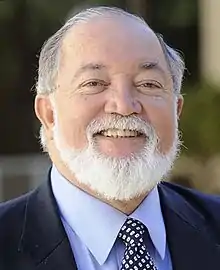 |
President (Head of state & head of government) |
1976–1977 | [47] | |
| Nuon Chea 農謝 |
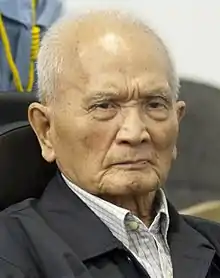 |
Prime Minister (acting) (Head of government) |
1976 | [48][49] | |
| Thanin Kraivichien 他寧·蓋威遷 |
 |
Prime Minister (Head of government) |
1976–1977 | [50] | |
| Kriangsak Chamanan 江薩·差瑪南 |
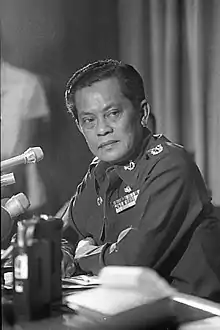 |
Prime Minister (Head of government) |
1977–1980 | ||
| Prem Tinsulanonda 炳·廷素拉暖 |
.jpg.webp) |
Prime Minister (Head of government) |
1980–1988 | [51] | |
| Julius Chan 陳仲民 |
Prime Minister (Head of government) |
1980–1982, 1994–1997 1997 |
[52] | ||
| Boonchu Rojanastien 汶初·洛乍納沙天 |
Deputy Prime Minister (Deputy head of government) |
1980–1981, 1992–1994 |
[53] | ||
| Henk Chin A Sen 陳亞先 |
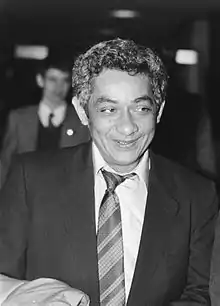 |
Prime Minister (Head of government) |
1980–1982 | ||
| President (Head of state) | |||||
| Musa Hitam 慕沙希淡 |
Deputy Prime Minister (Deputy head of government) |
1981–1986 | [54] | ||
| San Yu 山友 |
President (Head of state) |
1981–1988 | [55][56] | ||
| Chan Sy 姜西 |
Prime Minister (Head of government) |
1982–1984 | [57] | ||
| Hun Sen 洪森 |
_cropped_(2).jpg.webp) |
Prime Minister (Head of government) |
1984–present | [58][59] | |
| Ong Teng Cheong 王鼎昌 |
Deputy Prime Minister (Deputy head of government) |
1985–1993 | [60] | ||
| President (Head of state) |
1993–1999 | ||||
| Goh Chok Tong 吳作棟 |
 |
Deputy Prime Minister (Deputy head of government) |
1985–1990 | [61] | |
| Prime Minister (Head of government) |
1990–2004 | ||||
| Wee Kim Wee 黃金輝 |
President (Head of state) |
1985–1993 | [62] | ||
| Corazon Aquino 科拉松·阿基諾 |
 |
President (Head of state & head of government) |
1986–1992 | [32][63] | |
| Chatichai Choonhavan 差猜·春哈旺 |
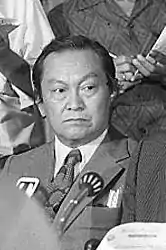 |
Deputy Prime Minister (Deputy head of government) |
1986–1988 | [32][64][65] | |
| Prime Minister (Head of government) |
1988–1991 | ||||
| Roh Tae-woo 盧泰愚 |
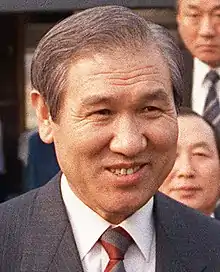 |
President (Head of state & head of government) |
1988–1993 | [66][67] | |
| Chuan Leekpai 川·立派 |
 |
Deputy Prime Minister (Deputy head of government) |
1988–1989 | [68][69] | |
| Prime Minister (Head of government) |
1992–1995, 1997–2001 | ||||
| Chavalit Yongchaiyudh 差瓦立·永猜裕 |
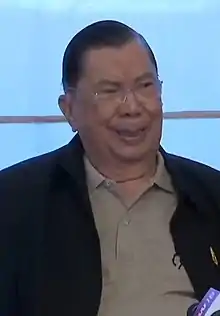 |
Deputy Prime Minister (Deputy head of government) |
1990, 1994, 1995–1996, 2001–2005 |
[70] | |
| Prime Minister (Head of government) |
1996–1997 | ||||
| Lee Hsien Loong 李顯龍 |
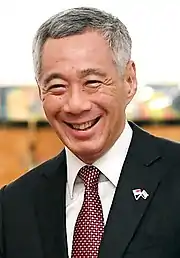 |
Deputy Prime Minister (Deputy head of government) |
1990–2004 | [71][72] | |
| Prime Minister (Head of government) |
2004–present | ||||
| Anand Panyarachun 阿南·班雅拉春 |
 |
Prime Minister (Head of government) |
1991–1992, 1992 |
[73][74] | |
| Chea Sim 謝辛 |
 |
Chairman (Head of state) |
1992–1993 | [75] | |
| Suchinda Kraprayoon 蘇欽達·甲巴允 |
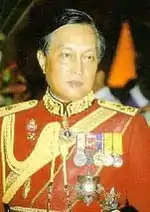 |
Prime Minister (Head of government) |
1992 | [76][77][78] | |
| Norodom Ranariddh 諾羅敦·拉那烈 |
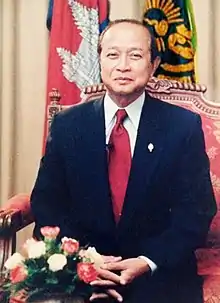 |
Prime Minister (Head of government) |
1993–1997 | [79] | |
| Hata Tsutomu 羽田孜 |
 |
Deputy Prime Minister (Deputy head of government) |
1993–1994 | [80][81] | |
| Prime Minister (Head of government) |
1994 | ||||
| Chamlong Srimuang 占隆·西蒙 |
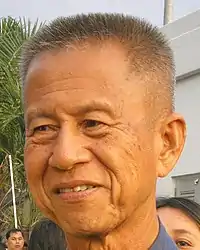 |
Deputy Prime Minister (Deputy head of government) |
1994–1995 | [82] | |
| Banharn Silpa-archa 班漢·西巴阿差 |
.jpg.webp) |
Prime Minister (Head of government) |
1995–1996 | [83] | |
| Thaksin Shinawatra 他信·西那瓦 |
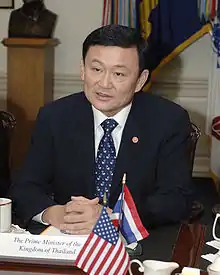 |
Deputy Prime Minister (Deputy head of government) |
1995–1997 | [84] | |
| Prime Minister (Head of government) |
2001–2006 | ||||
| Tony Tan Keng Yam 陳慶炎 |
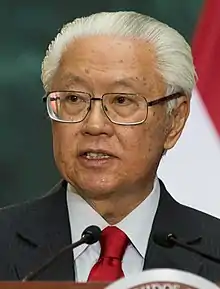 |
Deputy Prime Minister (Deputy head of government) |
1995–2005 | ||
| President (Head of state) |
2011–2017 | ||||
| Ung Huot 翁霍 |
Prime Minister (Head of government) |
1997–1998 | |||
| Supachai Panitchpakdi 素帕猜·帕尼帕迪 |
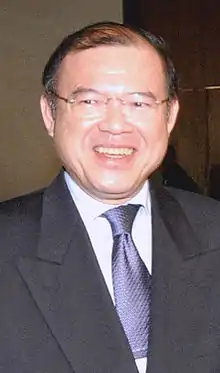 |
Deputy Prime Minister (Deputy head of government) |
1997–2000 | ||
| Somsavat Lengsavad 宋薩瓦·凌沙瓦 |
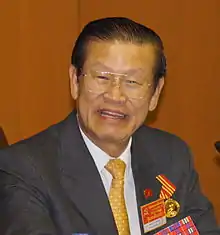 |
Deputy Prime Minister (Deputy head of government) |
1998–present | [85] | |
| Abdullah Ahmad Badawi 阿都拉·阿末·巴達威 |
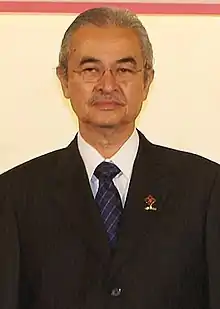 |
Deputy Prime Minister (Deputy head of government) |
1999–2003 | [86][87][88][89] | |
| Prime Minister (Head of government) |
2003–2009 | ||||
| Abdurrahman Wahid 阿卜杜拉赫曼·瓦希德 |
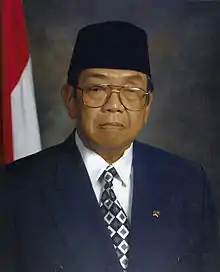 |
President (Head of state & head of government) |
1999–2001 | [90][91] | |
| Pongpol Adireksarn 邦汶·阿滴列山 |
Deputy Prime Minister (Deputy head of government) |
2001–2005 | |||
| Somkid Jatusripitak 頌奇·扎都西披塔 |
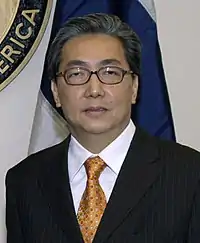 |
Deputy Prime Minister (Deputy head of government) |
2001–2002, 2003–2004, 2005–2006, 2015–2020 |
[92][93][94] | |
| Roh Moo-hyun 盧武鉉 |
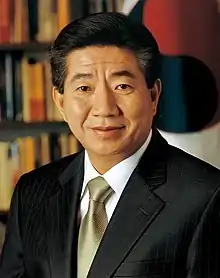 |
President (Head of state & head of government) |
2003–2008 | [66][95] | |
| Anote Tong 湯安諾 |
_(cropped).jpg.webp) |
President (Head of state & head of government) |
2003–2016 | [96] | |
| Khin Nyunt 欽紐 |
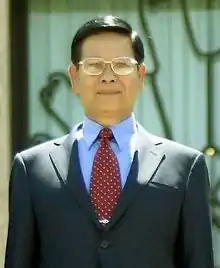 |
Prime Minister (Head of government) |
2003–2004 | [97][98] | |
| Oscar Temaru 奧斯卡·特馬魯 |
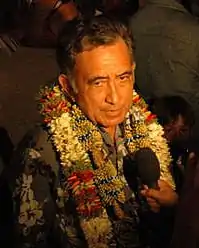 |
President (Head of government) |
2004, 2005–2006, 2007–2008, 2009, 2011–2013 |
[99][100] | |
| Lu Lay Sreng 楊來盛 |
Deputy Prime Minister (Deputy head of government) |
2004–? | [101] | ||
| Sok An 宋安 |
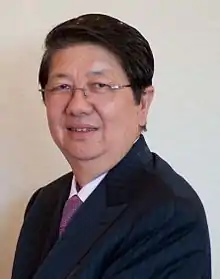 |
Deputy Prime Minister (Deputy head of government) |
2004–2017 | [102][103] | |
| Hor Namhong 賀南洪 |
 |
Deputy Prime Minister (Deputy head of government) |
2004–present | [104] | |
| Tea Banh 狄班 |
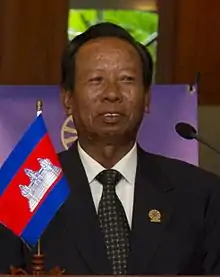 |
Deputy Prime Minister (Deputy head of government) |
2004–present | [105][106] | |
| Chitchai Wannasathit 七猜·萬那沙提 |
Deputy Prime Minister (Deputy head of government) |
2005–2006 | [107][108] | ||
| Prime Minister (acting) (Head of government) |
2006 | ||||
| Elias Camsek Chin 埃利亞斯·卡姆塞克·陳 |
 |
Vice President (Deputy head of state & deputy head of government) |
2005–2009 | ||
| Wong Kan Seng 黃根成 |
 |
Deputy Prime Minister (Deputy head of government) |
2005–2011 | ||
| Gaston Tong Sang 伽斯頓·唐生 |
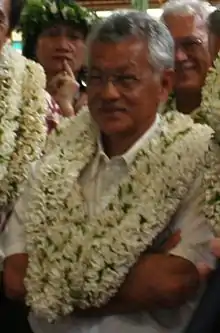 |
President (Head of government) |
2006–2007, 2008–2009, 2009–2011 |
[109] | |
| Samak Sundaravej 沙馬·順達衛 |
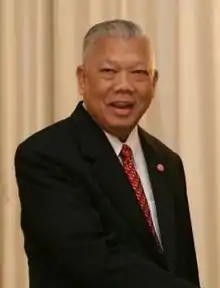 |
Prime Minister (Head of government) |
2008 | [110] | |
| Somchai Wongsawat 頌猜·旺沙瓦 |
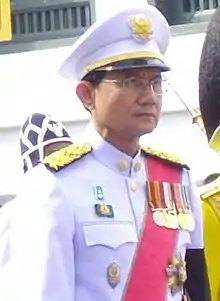 |
Deputy Prime Minister (Deputy head of government) |
2008 | [111] | |
| Prime Minister (Head of government) | |||||
| Chavarat Charnvirakul 差瓦拉·參威拉恭 |
.jpg.webp) |
Deputy Prime Minister (Deputy head of government) |
2008 | ||
| Prime Minister (acting) (Head of government) | |||||
| Abhisit Vejjajiva 阿披實·威差奇瓦 |
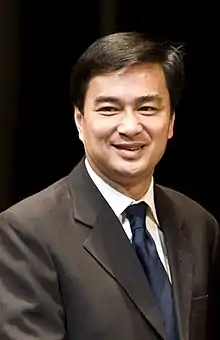 |
Prime Minister (Head of government) |
2008–2011 | [112][113] | |
| Teo Chee Hean 張志賢 |
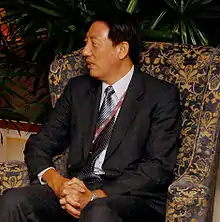 |
Deputy Prime Minister (Deputy head of government) |
2009–2019 | ||
| Benigno Aquino III 貝尼格諾·阿基諾三世 |
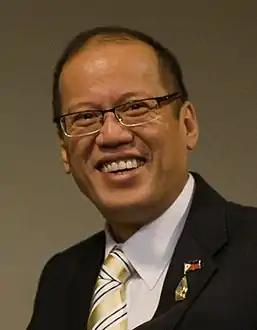 |
President (Head of state & head of government) |
2010–2016 | [114] | |
| Dési Bouterse 德西·鮑特瑟 |
 |
President (Head of state & head of government) |
2010–2020 | [115][116] | |
| Yingluck Shinawatra 英拉·西那瓦 |
_cropped.jpg.webp) |
Prime Minister (Head of government) |
2011–2014 | [84] | |
| Kittiratt Na-Ranong 吉提拉·納-雷朗 |
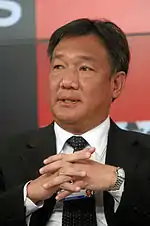 |
Deputy Prime Minister (Deputy head of government) |
2011–2014 | ||
| Luis Guillermo Solís 路易斯·吉列爾莫·索利斯 |
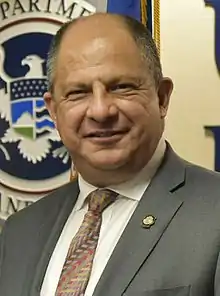 |
President (Head of state & head of government) |
2014–2018 | [117] | |
| Prayut Chan-o-cha 巴育·占奧差 |
 |
Prime Minister (Head of government) |
2014–present | [118][119] | |
| Prawit Wongsuwan 巴威·翁素萬 |
_cropped.jpg.webp) |
Deputy Prime Minister (Deputy head of government) |
2014–present | ||
| Rodrigo Duterte 羅德里戈·杜特爾特 |
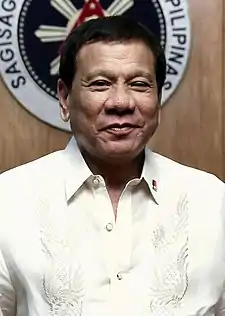 |
President (Head of state & head of government) |
2016–present | [120] | |
| Wan Azizah Wan Ismail 旺阿茲莎·旺依斯邁 |
.jpg.webp) |
Deputy Prime Minister (Deputy head of government) |
2018–2020 | [121] | |
| Heng Swee Keat 王瑞杰 |
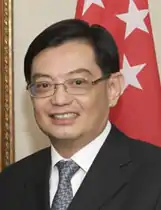 |
Deputy Prime Minister (Deputy head of government) |
2019–present | ||
| Horace Chang 霍勒斯·張 |
Deputy Prime Minister (Deputy head of government) |
2020–present |
Monarchical regimes and rulers
Dynasties
This is a list of dynasties—both sovereign and non-sovereign—outside of Greater China of partial or full Chinese heritage. Entries are sorted according to establishment dates.
| Dynasty | Realm | Period of rule | Founder | Remarks | Rulers |
|---|---|---|---|---|---|
| Hồng Bàng dynasty 鴻龐氏 |
Vietnam | 2879–258 BC | Lộc Tục 祿續 |
The founder of the legendary Hồng Bàng dynasty, Lộc Tục, was recorded as a descendant of the mythical Chinese ruler Shennong.[122] | (list) |
| Thục dynasty 蜀朝 |
Vietnam | 257–207 BC | Thục Phán 蜀泮 |
According to two historical Vietnamese texts, Đại Việt sử ký toàn thư and Khâm định Việt sử Thông giám cương mục, Thục Phán of the Thục dynasty was from modern-day Sichuan, China where it was previously ruled by the ancient Chinese State of Shu.[123][124][125][126] | (list) |
| Silla 新羅 |
Korea | 57 BC–AD 935 | Hyeokgeose 赫居世 |
The founder of Silla, Hyeokgeose, was of partial Chinese descent. His mother, Lady Saso, was from China and later settled in the Jinhan confederacy.[127][128] All Silla monarchs from the Bak clan were paternal descendants of Hyeokgeose, while those from the Seok clan (with the exception of Talhae) traced their lineage to Hyeokgeose via his granddaughter, Lady Ahyo (阿孝夫人; 아효부인). | (list) (tree) |
| Mahan confederacy 馬韓 |
Korea | 1st century BC–5th century AD | Jun 準 |
Jun was originally the final ruler of Jizi Chaoxian, descended from the Chinese sage Jizi, a noble of the Shang dynasty.[129] Following Wei Man's usurpation of Jun's throne, Jun fled southwards and assumed control of the Mahan confederacy.[130] | (list) |
| Dynasty II of Champa 占婆第二王朝 |
Lâm Ấp | AD 336–420 | Phạm Văn 范文 |
The founder of Dynasty II of Champa, Phạm Văn, was of Chinese origin.[131] | (list) |
| Early Lý dynasty 前李朝 |
Vietnam | AD 544–602 | Lý Bôn 李賁 |
The founder of the Early Lý dynasty, Lý Bôn, was descended from Chinese refugees who fled Wang Mang's seizure of power in the final years of the Western Han in China.[132][133][134][135][136][137][138] | (list) |
| Goryeo dynasty 高麗王朝 |
Korea | AD 918–1392 | Wang Geon 王建 |
The founder of the Goryeo dynasty, Wang Geon, was recorded as a 68th-generation descendant of Ji Feng, the founder of the ancient Chinese State of Wei.[139][140][141] According to Pyeonnyeon-Tong-Long (編年通錄; 편년통록), Wang Geon might have been a great-grandson of the Emperor Suzong of Tang; in Pyeonnyeongangmog (編年綱目; 변년강목), however, his great-grandfather was recorded as the Emperor Xuanzong of Tang.[142][143] | (list) (tree) |
| Later Sabeol 後沙伐 |
Korea | AD 919–927 | Bak Eon-chang 朴彦昌 |
The founder and only monarch of Later Sabeol, Bak Eon-chang, was a son of the 54th Silla king Bak Seung-yeong, who in turn was descended from Hyeokgeose of partial Chinese origin. | |
| Lý dynasty 李朝 |
Vietnam | AD 1009–1225 | Lý Công Uẩn 李公蘊 |
The first emperor of the Lý dynasty, Lý Công Uẩn, could have his paternal bloodline traced to modern-day Fujian, China.[144][145][146][147][148] Lý Công Uẩn's father, Lý Thuần An, escaped to Quanzhou from Hebei after Lý Công Uẩn's grandfather, Li Song, was wrongly accused of treason and executed by the Emperor Yin of Later Han.[149][150] | (list) (tree) |
| Trần dynasty 陳朝 |
Vietnam | AD 1225–1400 | Trần Cảnh 陳煚 |
The origin of the Trần dynasty was traced to modern Fujian, where the ancestor of the Trần imperial clan, Trần Kính, migrated from in the 11th century.[151][152] | (list) (tree) |
| Uthong dynasty 烏通王朝 |
Siam | AD 1350–1370, AD 1388–1409 |
Uthong 烏通 |
Uthong, the founder of the eponymous dynasty, was an ethnic Chinese.[153] This was also mentioned in a 17th-century account by Jeremias van Vliet. | (list) (tree) |
| Joseon dynasty 朝鮮王朝 |
Korea | AD 1392–1897 | Yi Dan 李旦 |
The founder of the Joseon dynasty, Yi Dan, was of mixed Chinese and Korean ancestry. His mother, Queen Uihye, was a Chinese from Deng Prefecture, China.[154][155] | (list) (tree) |
| Hồ dynasty 胡朝 |
Vietnam | AD 1400–1407 | Hồ Quý Ly 胡季犛 |
The Hồ dynasty claimed descent from the Duke Hu of Chen, the founder of the ancient Chinese State of Chen.[156][157] The Duke Hu of Chen was in turn descended from the legendary Emperor Shun, who was recognized by Hồ Quý Ly as the progenitor of the Hồ imperial family.[158][159] The Hồ family migrated from present-day Zhejiang, China to Vietnam under Hồ Hưng Dật during the 10th century.[150] | (list) (tree) |
| Later Trần dynasty 後陳朝 |
Vietnam | AD 1407–1413 | Trần Ngỗi 陳頠 |
The Later Trần dynasty was ruled by the same imperial clan as the earlier Trần dynasty. Trần Ngỗi, the founder of the Later Trần dynasty, was a son of the ninth Trần monarch, Trần Phủ. | (list) (tree) |
| Principality of Hà Tiên 河僊鎮 |
Hà Tiên | AD 1707–1802 | Mạc Cửu 鄚玖 |
The founder of the Principality of Hà Tiên, Mạc Cửu, was a Chinese from Leizhou, China.[160][161] | (list) |
| Thonburi dynasty 吞武里王朝 |
Siam | AD 1767–1782 | Taksin 達信 |
The founder and only king of the Thonburi dynasty, Taksin, had Chinese, Thai, and Mon ancestry. His father, Zheng Yong, was a Teochew Chinese from Chenghai, China.[162] | (list) (tree) |
| Tây Sơn dynasty 西山朝 |
Vietnam | AD 1778–1802 | Nguyễn Nhạc 阮岳 |
Rulers of the Tây Sơn dynasty, initially surnamed Hồ, were descended from the same line as the Hồ dynasty.[163] | (list) (tree) |
| Chakri dynasty 扎克里王朝 |
Siam / Thailand |
AD 1782–present | Thongduang 通鑾 |
The founder of the Chakri dynasty, Thongduang, was of mixed Chinese and Mon descent.[32][164] His mother, Daoreung, was partially Chinese.[165][166] | (list) (tree) |
| House of Norodom 諾羅敦王朝 |
Cambodia | AD 1860–1904, AD 1941–1970, AD 1993–present |
Ang Voddey 安瓦戴 |
Cambodian monarchs of the House of Norodom acquired Chinese heritage from Varni Van (萬妃; សម្តេចព្រះវររាជនីវ៉ាន់), a Chinese Cambodian consort of Sisowath. She was the maternal great-grandmother of Norodom Sihanouk (r. 1941–1955, 1993–2004) and the paternal great-great-grandmother of Norodom Sihamoni (r. 2004–present), the reigning Cambodian king. | (list) (tree) |
| House of Temenggong 天猛公王朝 |
Johor | AD 1886–present | Abu Bakar 阿布·峇卡 |
Johor monarchs of the House of Temenggong acquired Chinese heritage from Cecilia Catherina Lange,[167] the second wife of Abu Bakar with Chinese and Danish ancestry. Ibrahim (r. 1895–1959) and all subsequent Johor sultans, including the reigning Ibrahim Ismail (r. 2010–present), are descended from Lange. | (list) (tree) |
| Korean Empire 大韓帝國 |
Korea | AD 1897–1910 | Yi Hui 李㷩 |
The founder of the Korean Empire, Yi Hui, was the same person as the last Joseon king.[168] | (list) (tree) |
| House of Piang 皮昂王朝 |
Maguindanao people | 19th century–20th century AD | Piang Tan 陳皮昂 |
The founder of the House of Piang, Piang Tan, was of mixed Chinese and Maguindanaon heritage.[169][170][171][172][173][174][175] His father, Tuya Tan, was from Amoy, China. | |
| House of Sisowath 西索瓦王朝 |
Cambodia | AD 1904–1941 | Ang Sar 安紹 |
Sisowath Monivong (r. 1927–1941), the second and final Cambodian monarch from the House of Sisowath, was of partial Chinese descent. His mother, Varni Van (萬妃; សម្តេចព្រះវររាជនីវ៉ាន់), was a Chinese Cambodian. | (list) (tree) |
Non-dynastic monarchs
This is a list non-dynastic monarchs outside of Greater China of partial or full Chinese heritage. Entries are sorted according to reign dates.
| Name | Realm | Reign | Ref. |
|---|---|---|---|
| Liang Daoming 梁道明 |
Palembang | 14th century–15th century AD | [176][177] |
Other politicians
This is a list of politicians who were/are not heads of state and heads of government outside of Greater China of partial or full Chinese heritage. Entries are sorted according to alphabetical order.
Australia
- Alec Fong Lim
- Bernice Pfitzner
- Bill O'Chee
- David Wang
- Dio Wang
- Ernest Wong
- Gai Brodtmann
- Gladys Liu
- Harry Chan
- Helen Bullock
- Helen Sham-Ho
- Henry Tsang
- Hong Lim
- Ian Goodenough
- Jack Ah Kit
- Jenny Leong
- Jing Lee
- John So
- Katrina Fong Lim
- Michael Choi
- Michael Johnson
- Ngaree Ah Kit
- Penny Wong
- Peter Wong
- Pierre Yang
- Tsebin Tchen
Cambodia
Canada
- Adrienne Clarkson
- Alan Lowe
- Alice Wong
- Anne Kang
- Arnold Chan
- Art Lee
- Bhutila Karpoche
- Billy Pang
- Bob Wong
- Cathy Wong
- Chin Lee
- Chungsen Leung
- Cynthia Lai
- Daisy Wai
- David Lam
- David Xiao
- Denzil Minnan-Wong
- Dicki Chhoyang
- Dorothy Kostrzewa
- Doug Bing
- Douglas Jung
- Gary Mar
- Geng Tan
- George Chow
- George Ho Lem
- Gordon Chong
- Han Dong
- Henry Woo
- Ida Chong
- Inky Mark
- Jason Luan
- Jean B. Lumb
- Jean Yip
- Jenny Kwan
- John Yap
- Josephine Pon
- Katrina Chen
- Kelvin Ng
- Kenny Chiu
- Kerry Jang
- Kristyn Wong-Tam
- Laurin Liu
- Lillian Dyck
- Mary Ng
- Mary-Woo Sims
- Meili Faille
- Michael Chan
- Michael Chong
- Michael Lee
- Norman Kwong
- Olivia Chow
- Patrick Wong
- Peter Wing
- Peter Wong
- Philip S. Lee
- Raymond Chan
- Raymond Louie
- Richard Lee
- Shaun Chen
- Shirley Hoy
- Simon De Jong
- Soo Wong
- Sophia Leung
- Tany Yao
- Ted Hsu
- Teresa Wat
- Teresa Woo-Paw
- Thomas Dang
- Tony Tang
- Tony Wong
- Victor Oh
- Vincent Ke
- Vivienne Poy
- Ying Hope
- Yuen Pau Woo
- Wai Young
Estonia
France
Gabon
Guyana
Honduras
Indonesia
Ireland
Jamaica
Japan
Kiribati
Malaysia
- Alice Lau
- Anuar Tan Abdullah
- Anthony Loke
- Cha Kee Chin
- Chan Foong Hin
- Chan Kong Choy
- Chan Ming Kai
- Chang Lih Kang
- Chen Man Hin
- Chew Hoong Ling
- Chew Mei Fun
- Chin Peng
- Chong Chieng Jen
- Chong Eng
- Chong Hon Nyan
- Chong Sin Woon
- Choong Shiau Yoon
- Chor Chee Heung
- Chow Kon Yeow
- Christina Liew
- Chua Jui Meng
- Chua Soi Lek
- Chua Soon Bui
- Chua Tee Yong
- Chua Tian Chang
- Chung Keng Quee
- Chung Kok Ming
- Chung Thye Phin
- Daniel Wa Wai How
- David E. L. Choong
- Ding Kuong Hiing
- Edmund Chong Ket Wah
- Elizabeth Wong
- Er Teck Hwa
- Fan Yew Teng
- Fatimah Abdullah
- Fong Chan Onn
- Fong Kui Lun
- Fong Po Kuan
- Frankie Gan
- Gan Peck Cheng
- Gan Ping Sieu
- George Chan Hong Nam
- Goh Hock Guan
- Goh Leong San
- Gooi Hsiao Leung
- H. S. Lee
- Hannah Yeoh
- Hee Loy Sian
- Hee Tien Lai
- Hiew King Cheu
- Hoh Khai Mun
- Hou Kok Chung
- James Wong Kim Min
- Jeff Ooi
- Julian Tan
- June Leow
- Kathleen Wong
- Kelvin Yii Lee Wuen
- Kerk Choo Ting
- Kerk Kim Hock
- Khoo Poay Tiong
- Khoo Soo Seang
- Ko Chung Sen
- Koh Nai Kwong
- Koh Tsu Koon
- Kong Cho Ha
- Lai Meng Chong
- Lai Teck
- Larry Sng
- Law Choo Kiang
- Law Hieng Ding
- Lee Boon Chye
- Lee Chee Leong
- Lee Hwa Beng
- Lee Kim Sai
- Lee Kim Shin
- Lee Lam Thye
- Lee Loy Seng
- Lee San Choon
- Lee Yoon Thim
- Leong Yew Koh
- Liang Teck Meng
- Liew Chin Tong
- Liew Vui Keong
- Lim Ah Lek
- Lim Boo Chang
- Lim Chong Eu
- Lim Guan Eng
- Lim Keng Yaik
- Lim Kit Siang
- Lim Lip Eng
- Lim Swee Aun
- Linda Tsen
- Ling Liong Sik
- Liow Tiong Lai
- Loh Gwo Burne
- Lye Siew Weng
- Mah Hang Soon
- Mah Siew Keong
- Maria Chin Abdullah
- Mary Yap
- Michael Chen
- Michael Teo Yu Keng
- Mohamad Fatmi Che Salleh
- Mohammad Nizar Jamaluddin
- Mohamed Rahmat
- Nathaniel Tan
- Ng Wei Aik
- Ng Yen Yen
- Nga Kor Ming
- Ngeh Koo Ham
- Noor Hisham Abdullah
- Nur Jazlan Mohamed
- Nurul Izzah Anwar
- Ong Ka Chuan
- Ong Ka Ting
- Ong Kee Hui
- Ong Kian Ming
- Ong Tee Keat
- Ong Yoke Lin
- Oscar Ling
- Pang Hok Liong
- Paul Leong Khee Seong
- Peter Chin Fah Kui
- Peter Lo Su Yin
- Poh Ah Tiam
- Richard Ho
- Robert Lau
- Sebastian Ting Chiew Yew
- See Chee How
- Sim Kui Hian
- Sim Tong Him
- Sim Tze Tzin
- Soh Chin Aun
- Stephen Kalong Ningkan
- Stephen Yong Kuet Tze
- Steven Sim
- Su Keong Siong
- Suriani Abdullah
- Tan Ah Eng
- Tan Chai Ho
- Tan Chee Khoon
- Tan Cheng Lock
- Tan Kee Kwong
- Tan Kok Wai
- Tan Koon Swan
- Tan Lian Hoe
- Tan Seng Giaw
- Tan Siew Sin
- Tan Tee Beng
- Tan Tong Hye
- Tan Yee Kew
- Tang Heap Seng
- Tee Hock Seng
- Tee Siew Kiong
- Teh Chai Ann
- Teh Kok Lim
- Teng Boon Soon
- Teo Kok Seong
- Teo Nie Ching
- Teresa Kok
- Ting Chew Peh
- Tiong King Sing
- Tiong Thai King
- Tony Pua
- Victor Gu
- Violet Yong
- Vivian Wong Shir Yee
- Wee Choo Keong
- Wee Jeck Seng
- Wee Ka Siong
- William Leong
- Wong Chen
- Wong Foon Meng
- Wong Ho Leng
- Wong Hon Wai
- Wong Kah Woh
- Wong Ling Biu
- Wong Pow Nee
- Wong Sai Hou
- Wong Shu Qi
- Wong Soon Koh
- Wong Sze Phin
- Wong Tack
- Wong Tien Fatt
- Yap Ah Loy
- Yap Pian Hon
- Yeo Bee Yin
- Yeow Chai Thiam
- Yong Khoon Seng
- Yong Teck Lee
Mexico
Myanmar
The Netherlands
New Zealand
Norway
Pakistan
Papua New Guinea
The Philippines
- Abdusakur Mahail Tan
- Abraham Tolentino
- Alberto Lim
- Alfonso Yuchengco
- Alfredo Lim
- Amelia Gordon
- Ananias Laico
- Antonio Tinio
- Arnold Atienza
- Arsenio Lacson
- Arthur C. Yap
- Betty Go-Belmonte
- Bong Go
- Chel Diokno
- Claudio Teehankee
- Danding Cojuangco
- Danilo Lim
- Dennis Uy
- Dino Reyes Chua
- Francis Escudero
- Francis Garchitorena
- Gemma Cruz-Araneta
- Gilbert Teodoro
- Gina Lopez
- Gregory S. Ong
- Herbert Bautista
- Imee Marcos
- Jaime Ongpin
- Jaime Sin
- Jesse Robredo
- José Cojuangco
- Jose Diokno
- Jose Maria Sison
- Joy Belmonte
- Lito Atienza
- Lucy Torres Gomez
- Luis Yangco
- Manuel Tinio
- Marcial Lichauco
- Mark Cojuangco
- Nikki Coseteng
- Panfilo Lacson
- Pedro Yap
- Peping Cojuangco
- Raul Roco
- Reno Lim
- Rex Gatchalian
- Rogelio de la Rosa
- Roy Chiongbian
- Ruthlane Uy Asmundson
- Wenceslao Vinzons
- Win Gatchalian
Ryukyu Kingdom
Samoa
Singapore
- Abdullah Tarmugi
- Alex Yam
- Aline Wong
- Alvin Tan
- Alvin Yeo
- Amy Khor
- Ang Hin Kee
- Ang Mong Seng
- Ang Wei Neng
- Ang Yong Guan
- Arthur Fong
- Baey Yam Keng
- Benjamin Pwee
- Cedric Foo
- Chan Choy Siong
- Chan Chun Sing
- Chan Soo Sen
- Charles Chong
- Chay Wai Chuen
- Chee Hong Tat
- Chee Soon Juan
- Chen Show Mao
- Cheng Li Hui
- Cheo Chai Chen
- Cheryl Chan
- Chew Swee Kee
- Chia Shi-Lu
- Chia Thye Poh
- Chiam See Tong
- Chin Harn Tong
- Chin Tet Yung
- Chng Hee Kok
- Chong Kee Hiong
- Choo Wee Khiang
- Chor Yeok Eng
- Chua Sian Chin
- Cynthia Phua
- Daniel Goh
- Darryl David
- David Ong
- Denise Phua
- Dennis Tan
- Desmond Choo
- Desmond Lee
- Desmond Lim
- Desmond Tan
- Dixie Tan
- Don Wee
- Edwin Tong
- Ellen Lee
- Eric Chua
- Foo Mee Har
- Francis Seow
- Gan Kim Yong
- Gan Siow Huang
- Gan Thiam Poh
- George Yeo
- Gerald Giam
- Goh Meng Seng
- Grace Fu
- Hazel Poa
- He Ting Ru
- Heng Chee How
- Henry Kwek
- Ho Geok Choo
- Ho Kah Leong
- Ho Peng Kee
- Hon Sui Sen
- Howe Yoon Chong
- Indranee Rajah
- Irene Ng
- Jamus Lim
- Jek Yeun Thong
- Jessica Tan
- Josephine Teo
- Ker Sin Tze
- Khaw Boon Wan
- Koh Poh Koon
- Koo Tsai Kee
- Lam Pin Min
- Lawrence Wong
- Lee Bee Wah
- Lee Boon Yang
- Lee Chiaw Meng
- Lee Khoon Choy
- Lee Li Lian
- Lee Yi Shyan
- Lee Yock Suan
- Leong Mun Wai
- Lew Syn Pau
- Liang Eng Hwa
- Lily Neo
- Lim Biow Chuan
- Lim Boon Heng
- Lim Chin Siong
- Lim Hng Kiang
- Lim Hwee Hua
- Lim Kim San
- Lim Swee Say
- Lim Tean
- Lim Wee Kiak
- Lina Loh
- Ling How Doong
- Liu Thai Ker
- Loh Miaw Gong
- Louis Chua
- Louis Ng
- Low Thia Khiang
- Low Yen Ling
- Lui Tuck Yew
- Mah Bow Tan
- Matthias Yao
- Melvin Yong
- Ng Chee Meng
- Ng Eng Hen
- Ng Ling Ling
- Ng Pock Too
- Ong Chit Chung
- Ong Eng Guan
- Ong Pang Boon
- Ong Ye Kung
- Ooi Boon Ewe
- Patrick Tay
- Peh Chin Hua
- Penny Low
- Png Eng Huat
- Raymond Lim
- Richard Hu
- Sam Tan
- Seah Kian Peng
- Seet Ai Mee
- Seng Han Thong
- Shawn Huang Wei Zhong
- Sim Ann
- Sin Boon Ann
- Sitoh Yih Pin
- Steve Chia
- Sun Xueling
- Sylvia Lim
- Tan Cheng Bock
- Tan Chuan-Jin
- Tan Jee Say
- Tan Kiat How
- Tan Kin Lian
- Tan See Leng
- Tan Soo Khoon
- Tan Wu Meng
- Tay Eng Soon
- Teh Cheang Wan
- Teo Ho Pin
- Teo Ser Luck
- Tin Pei Ling
- Tony Tan Lay Thiam
- Vivian Balakrishnan
- Walter Woon
- Wan Soon Bee
- Wee Siew Kim
- Xie Yao Quan
- Yee Jenn Jong
- Yeo Cheow Tong
- Yeo Guat Kwang
- Yeo Ning Hong
- Yeo Wan Ling
- Yeoh Ghim Seng
- Yong Nyuk Lin
- Yu-Foo Yee Shoon
- Zeng Guoyuan
Solomon Islands
South Africa
South Korea
Soviet Union
Switzerland
Thailand
- Apirak Kosayodhin
- Bhichit Rattakul
- Chuwit Chitsakul
- Chuwit Kamolvisit
- Giles Ji Ungpakorn
- Jermmas Chuenglertsiri
- Kalaya Sophonpanich
- Kanawat Chantaralawan
- Kantathi Suphamongkhon
- Khaw Soo Cheang
- Korn Chatikavanij
- Kraisak Choonhavan
- Luang Wichitwathakan
- Parit Wacharasindhu
- Phraya Ratsadanupradit Mahitsaraphakdi
- Piyabutr Saengkanokkul
- Thammarak Isarangkura na Ayudhaya
- Thanathorn Juangroongruangkit
- Thepthai Senapong
- Weng Tojirakarn
Trinidad and Tobago
United Kingdom
United States
- Aaron Ling Johanson
- Allan Fung
- Alex Sink
- Alex Wan
- Andrew Yang
- Angie Chen Button
- Anna Chennault
- Barry Chang
- Barry Wong
- Bertha Kawakami
- Betty Tom Chu
- Betty Yee
- Calvin Say
- Carmen Chu
- Carol Liu
- Charles Djou
- Charlie Chong
- Cheryl Chow
- Cheryl Lau
- Chris Lu
- Christian Fong
- Chuck Mau
- Clayton Hee
- Conrad Lee
- Cory Fong
- Daniel Akaka
- David Chiu
- David Kuo
- David M. Louie
- David S. C. Chu
- David Wu
- Derek Kan
- Donald Wong
- Doug Chin
- Duke Aiona
- Ed Chau
- Ed Jew
- Ed Lee
- Edmond J. Gong
- Edmund C. Moy
- Elaine Chao
- Elisa Chan
- Ellen Young
- Eric Mar
- Ervin Yen
- Evan Low
- Fiona Ma
- Frederick Pang
- Gary Locke
- Gene Wu
- Gordon Lau
- Gordon Quan
- Grace Meng
- Harry Lee
- Hiram Fong
- Isaac Choy
- James C. Ho
- James Kealoha
- Jan C. Ting
- Jean Quan
- Jeff Tien Han Pon
- Jessie Liu
- Jim Chu
- Jimmie R. Yee
- Jimmy Meng
- John B. Tsu
- John Chiang
- John Liu
- Joseph Apukai Akina
- Judy Chu
- Julia Chang Bloch
- Kaniela Ing
- Kansen Chu
- Karen Goh
- Katy Tang
- Kimberly Yee
- Kris Wang
- Lanhee Chen
- Leland Yee
- Lily Qi
- Lindy Li
- Ling Ling Chang
- Lisa Wong
- Mae Yih
- March Fong Eu
- Margaret Chin
- Martha Wong
- Matt Fong
- Mia Gregerson
- Michael Woo
- Michelle K. Lee
- Michelle Wu
- Mike Eng
- Mike Gin
- Mike Yin
- Ming Chin
- Nancy-Ann DeParle
- Norman Yee
- Otto Lee
- Paul Fong
- Peter Koo
- Phil Ting
- Phillip Chen
- Richard Pan
- Ruby Chow
- Rui Xu
- S. B. Woo
- Sandra Lee Fewer
- Sonia Chang-Díaz
- Stanley Chang
- Stephanie Chang
- Steven Chu
- Sue Chew
- Susan C. Lee
- Suzanne Chun Oakland
- Tammy Duckworth
- Ted Lieu
- Teodoro R. Yangco
- Theresa Mah
- Tina Tchen
- TJ Cox
- Tom Hom
- Tony Hwang
- Vince Fong
- William S. Richardson
- William Tong
- Wilma Chan
- Wing F. Ong
- Wing Luke
- Yiaway Yeh
- Yuh-Line Niou
Vietnam
Zimbabwe
See also
Notes
- There may be different variants of Chinese transliteration for a non-Chinese name. For example, the Chinese name of Yingluck Shinawatra is rendered as "英拉·西那瓦" in mainland China, "英祿·西那瓦" in Hong Kong and Macau, "盈拉·欽那瓦" in Taiwan, "英叻·欽那瓦" in Malaysia and Singapore, and "英樂·秦那越" in Thailand.
References
- Fabonan III, Epi (16 February 2018). "Aquino's Chinese ancestry fuels anger in Beijing". The Philippine Star. Retrieved 27 October 2020.
- Tan, Chee-Beng (2004). Chinese Overseas: Comparative Cultural Issues. p. 38. ISBN 9789622096615.
- Preston et al. (1997), p. 464; 51. Phya Manopakarana Nitidhada. He spoke perfect English and was always very friendly to England. Is three parts Chinese. His wife, who was a favourite lady-in-waiting to the ex-Queen, was killed in a motor accident in 1929 when on an official visit to Indo-China.
- George William Skinner (1957). Chinese Society in Thailand: An Analytical History. Cornell University Press. p. 244.
- D. Insor (1957). Thailand: A Political, Social, and Economic Analysis. Praeger. p. 138.
- Flores, Wilson Lee (13 July 2008). "Love in the time of war: Manuel Quezon's dad, Anne Curtis, Jericho Rosales & Ed Angara in Baler". PhilStar Global Sunday Lifestyle. Retrieved 17 May 2019.
- Viray, Patricia (26 September 2019). "Fact check: Sergio Osmeña was actually the first Chinese Filipino senator". The Philippine Star. Retrieved 27 October 2020.
- Batson, Benjamin Arthur; Shimizu, Hajime (1990). The Tragedy of Wanit: A Japanese Account of Wartime Thai Politics. University of Singapore Press. p. 64. ISBN 9971622467. Retrieved 29 September 2018.
- Sierra, Jerry A. "Fulgencio Batista, from army sergeant to dictator". www.historyofcuba.com.
- Havana By Brendan Sainsbury .
- Fidel Castro's Road to Power, Volume 1.
- Goscha, Christopher E., Thailand and the Southeast Asian Networks of The Vietnamese Revolution, 1885-1954, Routledge, 1999, p. 42 ISBN 0700706224
- Corfield, Justin J. (2009). The History of Cambodia. ABC-CLIO. p. 35. ISBN 978-0313357237.: "The first of the Khmer Krom to arrive on the scene in Phnom Penh was Son Ngoc Thanh. Thanh had been born in Cochinchina, and his father was a Khmer Krom landowner, while his mother was from a Chinese-Vietnamese family."
- An Impressive Day at M.R. Kukrit's Home Archived 27 September 2007 at the Wayback Machine; Thailand Bibliography
- Gerald W. Fry (18 June 2012). "Research & Articles on Pridi Banomyong". BookRags. Archived from the original on 2011-10-30.
Pridi was included in UNESCO's list of Great Personalities and Historic Events for the year 2000, and this year was declared by UNESCO as the centennial of Pridi. Also, the Université Paris (1 PanthéonSorbonne) in 2000 celebrated the centenary of Pridi and honored him as "one of the great constitutionalists of the twentieth century," comparing him to such figures as Rousseau, Montesquieu, and de Tocqueville.
- [泰国] 洪林, 黎道纲主编 (April 2006). 泰国华侨华人研究 (in Chinese). 香港社会科学出版社有限公司. p. 17. ISBN 962-620-127-4.
- [泰国] 洪林, 黎道纲主编 (April 2006). 泰国华侨华人研究 (in Chinese). 香港社会科学出版社有限公司. pp. 17, 185. ISBN 962-620-127-4.
- 臺北科技大學紅樓資訊站 (in Chinese). National Taipei University of Technology. Archived from the original on 28 September 2007.
- Syngman Rhee was descended from Taejong of Joseon whose paternal grandmother was Chinese.
• "Rhee Syngman, First President of the Republic of Korea".
• Encyclopedia of Korean Culture 의혜왕후 懿惠王后. Encyclopedia of Korean Culture. Retrieved 2017-01-30.
• Doosan Encyclopedia 의혜왕후 懿惠王后. Doosan Encyclopedia. Retrieved 2017-01-30. - Lee Beom-seok was descended from a son of Sejong of Joseon.
• "철기 이범석 장군 기념사업회('Chulgi' Lee Beom-seok General's Anniversary) : Lee Beom-Seok(이범석)".
One of Sejong's great-grandmother was Chinese.
• Encyclopedia of Korean Culture 의혜왕후 懿惠王后. Encyclopedia of Korean Culture. Retrieved 2017-01-30.
• Doosan Encyclopedia 의혜왕후 懿惠王后. Doosan Encyclopedia. Retrieved 2017-01-30. - Enriquez, Marge (16 July 2020). "How Eugenio "Geny" Lopez Jr Founded and Grew the ABS-CBN Empire". Tatler. Retrieved 27 October 2020.
- Lau, Albert, "Lim Yew Hock", Oxford Dictionary of National Biography. Oxford University Press, 2004.
- [泰国] 洪林, 黎道纲主编 (April 2006). 泰国华侨华人研究 (in Chinese). 香港社会科学出版社有限公司. p. 187. ISBN 962-620-127-4.
- Chaloemtiarana, Thak (2007), Thailand: The Politics of Despotic Paternalism, Ithaca NY: Cornell Southeast Asia Program, p. 88, ISBN 978-0-8772-7742-2
- Smith, Martin (6 December 2002). "General Ne Win". The Guardian. Retrieved 8 April 2012.
- Gale, T. 2005. Encyclopedia of World Biographies.
- Smith Nieminen Win (2005). Historical Dictionary of Thailand (2nd ed.). Praeger Publishers. p. 225. ISBN 978-0-8108-5396-6.
- Richard Jensen, Jon Davidann, Sugita (2003). Trans-Pacific Relations: America, Europe, and Asia in the Twentieth Century. Praeger Publishers. p. 222. ISBN 978-0-275-97714-6.CS1 maint: multiple names: authors list (link)
- "Dr. Toh Chin Chye visiting the Toh clan ancestral shrine in China, 1985".
- Low, Shawn; McCrohan, Daniel (2012). Singapore. Lonely Planet. ISBN 978-1-74220-854-1.
- Lee Kuan Yew (2000). From Third World to First. Singapore: Marshall Cavendish.
- Lim, Hua Sing (2008). Japan and China in East Asian Integration. p. 289. ISBN 9789812307446.
- White, Lynn (2014). Philippine Politics: Possibilities and Problems in a Localist Democracy. p. 16. ISBN 9781317574224.
- Mijares, Primitivo (1976). The Conjugal Dictatorship of Ferdinand and Imelda Marcos (PDF). Union Square Publications. p. 255. Archived from the original (PDF) on February 18, 2018. Retrieved January 19, 2019.
- Summary of world broadcasts: Far East, Part 3, 24 July 1984, p. FE/7703/C/12 He was given a sumptuous welcome and was even offered the opportunity to visit the grave of his grandfather in Fujian Province. It is worth noting that on this occasion, the Chinese leaders voiced support for Lon Nol's.....
- "Obituary - Arthur Chung". June 29, 2008.
- "Guyana’s first President dies" Archived 14 February 2009 at the Wayback Machine, GINA, 23 June 2008.
- Ismail, Tawfik; Ooi, Kee Beng. REVIEW of The Reluctant Politician: Tun Dr Ismail and His Time.
- 梁明 (Liang, Ming), "高棉華僑概況 (Overview of the Khmer Chinese)–海外華人青少年叢書", 1988, 华侨协会总会主编–正中书局印行, page 27
- "Goh Keng Swee".
- Bora, Touch (February 2005). "Debating Genocide". The Phnom Penh Post. Archived from the original on 25 November 2007. Retrieved 19 November 2007.
- Bora, Touch. "Jurisdictional and Definitional Issues". Khmer Institute. Retrieved 19 November 2007.
- Short, Philip (2004). Pol Pot: The History of a Nightmare. London: John Murray. ISBN 978-0719565694.
- Kim Keo Kanitha, Choung Sphearith and Long Dany. "Magazine of the Documentation Center of Cambodia–Ieng Sary's Brief Biography" (PDF) (Special English Edition, April 2003): 8. Retrieved 2012-06-23. Cite journal requires
|journal=(help) - Bora, Touch. "Jurisdictional and Definitional Issues". Khmer Institute. Retrieved 2007-11-19.
- Sann Rada, Transcript of Trial Proceedings–Case File Nº 002/19-09-2007-ECCC/TC, Day 4–5 December 2011, Extraordinary Chambers in the Courts of Cambodia, retrieved 29 October 2013
- 珠璣巷移民後裔的海外拓殖·曾祥委、曾漢祥
- Eiji Murashima, The Young Nuon Chea in Bangkok (1942 1950)and the Communist Party of Thailand: The Life in Bangkok of the Man Who Became “Brother No. 2” in the Khmer Rouge Archived 15 August 2011 at the Wayback Machine, Journal of Asia-Pacific Studies (Waseda University) No. 12 (March 2009), retrieved 29 October 2013
- Sann Rada, Transcript of Trial Proceedings–Case File Nº 002/19-09-2007-ECCC/TC, Day 4–5 December 2011, Extraordinary Chambers in the Courts of Cambodia, retrieved 29 October 2013
- Peagam, Nelson (1976), "Judge picks up the reigns", Far Eastern Economic Review, p. 407
- ประวัติ พลเอกเปรม ติณสูลานนท์. pramlatter.tripod.com (in Thai).
- "Life’s a mystery – Sir J speaks about his 80 years", The National (Papua New Guinea), 06 September 2019.
- Chris Baker, Pasuk Phongpaichit. A History of Thailand. Cambridge University Press. pp. 280. ISBN 0-521-81615-7.
- Dhillon, Karminder Singh (2009). Malaysian Foreign Policy in the Mahathir Era, 1981-2003: Dilemmas of Development. p. 24. ISBN 9789971693992.
- Choy, Lee Khoon (26 March 2013). Golden Dragon and Purple Phoenix: The Chinese and Their Multi-Ethnic Descendants in Southeast Asia. ISBN 9789814518499.
- SAN YU, 78 Asiaweek.com
- Heng Sophat: Interview 1a. Segment 10
- Forest (2008), p. 178 "Sino-khmer originaire du district de Krauch Chmar 140, Hun Sèn descend par ses grands-parents paternels d'une famille de propriétaires terriens qui paraît correspondre au stéréotype du Chinois - téochiew ? - implanté en zone rurale, c'est-à-dire aisée mais sans pouvoir administratif. Par sa mère, il descendrait inversement d'une tête de réseau....."
- Time, Volume 136 (1990), p. 329 Beijing has not softened its hostility toward Hun Sen, but there are subtle signs that China may yet shift its position. Some officials now mention that Hun Sen's grandfather was Chinese, seeming to hint at the possibility of a new....
- Sim, Walter (31 January 2016). "Changes to Elected Presidency: Ensuring minorities have a turn". The Straits Times. Retrieved 27 October 2020.
- 闽籍华侨华人社团 Archived 22 December 2015 at the Wayback Machine
- "Wee Kim Wee".
- Esmaque II, Paterno (8 June 2015). "Malacañang on China dispute: Aquino has Chinese roots". Rappler. Retrieved 27 October 2020.
- 曾经叱咤风云的泰国政坛澄海人. ydtz.com (in Chinese). Archived from the original on 28 September 2007.
- Close bond with China inherited from ancestors
- "Former Thai Prime Minister and beauty Yingluck said: "My ancestor is Jiang Ziya", do you agree?".
- "历数有中国血统的外国领导人".
- Baker, Chris; Phongpaichit, Pasuk (2009). A History of Thailand (2nd, paper ed.). Cambridge University Press. ISBN 9780521759151.
- 泰国华裔地位高 出过好几任总理真正的一等公民. Sohu (in Chinese).
- Duncan McCargo, Ukrist Pathmanand (2004). The Thaksinization Of Thailand. Nordic Institute of Asian Studies. p. Introduction: Who is Thaksin Shinawatra?, 4. ISBN 978-87-91114-46-5.
- "新加坡內閣資政李光耀". big5.xinhuanet.com (in Chinese). 31 December 2008. Archived from the original on 31 December 2008. Retrieved 13 September 2020.
- "李光耀劝扁勿藉奥运搞台独". zaobao.com (in Chinese). 30 December 2008. Archived from the original on 30 December 2008. Retrieved 13 September 2020.CS1 maint: unfit URL (link)
- Chris Baker, Pasuk Phongpaichit (20 April 2005). A History of Thailand. Cambridge University Press. pp. 154 and 280. ISBN 0-521-81615-7.
- [泰国] 洪林, 黎道纲主编 (April 2006). 泰国华侨华人研究. 香港社会科学出版社有限公司. p. 185. ISBN 962-620-127-4.
- "Chea Sim: Politician who left the Khmer Rouge and became a key figure in Cambodia after the fall of the brutal regime". The Independent. Retrieved 21 September 2015.
- 泰国华裔总理不忘"本". csonline.com.cn (in Chinese). Archived from the original on 22 April 2009.
- [泰国] 洪林, 黎道纲主编 (April 2006). 泰国华侨华人研究 (in Chinese). 香港社会科学出版社有限公司. p. 185. ISBN 962-620-127-4.
- The days before ceasefire between SLORC AND NMSP on 25 June 1995 Archived 17 March 2008 at the Wayback Machine
- Members of the House of Norodom acquired Chinese heritage from Varni Van (萬妃; សម្តេចព្រះវររាជនីវ៉ាន់), a Chinese Cambodian consort of Sisowath. She was the paternal great-great-grandmother of Norodom Ranariddh.
- "农业考古". Newsletter for Research in Chinese Studies (5): 306. 2008. Retrieved 11 November 2020.
- Ni, Liqiu (2009). 新移民小说研究. p. 24. ISBN 9787313058508.
- Duncan McCargo, "The three paths of Major-General Chamlong Srimuang"
- "Former PM Banharn dies at 83". Bangkok Post. 23 April 2016.
- Tumcharoen, Surasak (29 November 2009). "A very distinguished province: Chanthaburi has had some illustrious citizens". Bangkok Post.
- (in Chinese) 排除“祖籍”障碍 华裔首次当选老挝政治局委员
- Backman, Michael. Asia Future Shock: Business Crisis and Opportunity in the Coming Years, Palgrave Macmillan, 2008, ISBN 978-0-230-00677-5, p. 133.
- PM meets relatives from China Archived 15 November 2013 at the Wayback Machine, The Star Online, 22 December 2003.
- http://radaris.asia/p/Su/Chiang/
- "Chinese/Native intermarriage in Austronesian Asia".
- Lindsey, Tim; Pausacker, Helen (2005). Chinese Indonesians: Remembering, Distorting, Forgetting. p. 102. ISBN 9789812303035.
- Lim, Hua Sing (2008). Japan and China in East Asian Integration. p. 290. ISBN 9789812307446.
- Somkid promises he'll do it his way
- YaleGlobal
- 泰国副总理颂奇回汕省亲祭祖 林木声黄志光等前往机场迎接 Archived March 3, 2016, at the Wayback Machine
- "姜子牙的后代不光有泰国美女总理英拉,还有这位韩国总统".
- "Tiny Pacific islands play China using the Taiwan card". Theage.com.au. 2003-11-10. Retrieved 2015-12-07.
- Kuppuswamy, C.S. (11 September 2004). "Myanmar: The shake- up and the fall out". South Asia Analysis Group. Archived from the original on 27 September 2007. Retrieved 22 May 2006.
- "钦纽1939年出生于缅甸孟邦首府毛淡棉。父母都是来自广东梅县的客家人". Archived from the original on 20 August 2016.
- "Logiques " autonomiste " et " indépendantiste " en Polynésie française". Archived from the original on 2009-01-24. Retrieved 2018-12-15.
- Ron Crocombe (2007). Asia in the Pacific Islands. University of the South Pacific, Institute of Pacific Studies. p. 103. ISBN 978-982-02-0388-4.
- 抓先進性教育 促僑聯事業發展, 2005-3-30, 揭陽市僑聯
- (in Chinese) 二战以来柬埔寨华人社会地位的变化, Zhuang Guotu (庄国土), No. 3–2004, Department of Southeast Asian studies, Xiamen University (厦门大学东南亚研究中心)
- "Sok An". Archived from the original on 6 March 2016. Retrieved 6 April 2017.
- Lee, Khoon Choy (2013). Golden Dragon And Purple Phoenix: The Chinese And Their Multi-ethnic Descendants In Southeast Asia. p. 301. ISBN 9789814518499.
- 吴锐成主任出席柬埔寨中国港澳侨商总会十周年会庆 2008-03-19, Guangdong Qiaowang
- Asiaweek, Volume 15, Issues 40-51; Asiaweek Limited, 1989, p. 32, "So would Tea Banh, an ethnic Thai with extensive business contacts in Thailand."
- 泰国新政府的华裔光芒 (in Chinese). Archived from the original on 29 September 2007.
- "ชิดชัย" หนุนแนวคิด "บิ๊กสุ" ตั้งคนกลางไกล่เกลี่ยปัญหา (in Thai).
- Gaston Tong Sang Elected French Polynesia President; Temaru To Seek Re-election In Tahiti Stalemate
- [泰国] 洪林, 黎道纲主编 (April 2006). 泰国华侨华人研究 (in Chinese). 香港社会科学出版社有限公司. p. 187. ISBN 962-620-127-4.
- Ahuja, Ambika (2008-09-09). "Cooking show stint derails Thai prime minister". Associated Press/Google. Archived from the original on 17 September 2008. Retrieved 2008-09-10.
- "Profile: Abhisit Vejjajiva". BBC News. 17 March 2010. Archived from the original on 8 February 2011. Retrieved 7 April 2011.
- "Archived copy". Archived from the original on 18 July 2011. Retrieved 7 April 2011.CS1 maint: archived copy as title (link)
- Esmaque II, Paterno (27 June 2015). "Aquino's Chinese ancestry fuels anger in Beijing". Rappler. Retrieved 27 October 2020.
- Bouterse achterachterkleinkind van Zeeuwse boerenzoon. Waterkant.net (Dutch)
- Joost Oranje, Desi Bouterse is al een mythe: sportleraar, legerleider, zakenman, NRC Handelsblad, 14 May 2005 (in Dutch)
- Dyer, Zach (3 November 2013). "Costa Rican presidential candidate Luis Guillermo Solís: 'It's not going to be business as usual'". The Tico Times. Retrieved 3 February 2014.
- http://www.ratchakitcha.soc.go.th/DATA/PDF/2559/D/087/19.PDF
- ประวัติการเรียน พล.อ.ประยุทธ์ จันทร์โอชา นายกรัฐมนตรีคนที่ 29 (in Thai). เอ็มไทย. 22 February 2015. Retrieved 5 July 2020.
- "Will playing the Chinese ancestry card help Rodrigo Duterte win over Beijing?". South China Morning Post. October 20, 2016. Retrieved April 3, 2020.
- Healy, Tim; Oorjitham, Santha (30 November 2000). "Readying for Elections?". Asiaweek. Archived from the original on 31 May 2018. Retrieved 11 May 2018.
- Vu, Hong Lien (2016). Rice and Baguette: A History of Food in Vietnam. ISBN 9781780237046.
- From Đại Việt sử ký toàn thư:
姓蜀,諱泮。巴蜀人也。
 Chinese Wikisource has original text related to this article: 钦定越史通鉴纲目/前编/卷之一
Chinese Wikisource has original text related to this article: 钦定越史通鉴纲目/前编/卷之一 - From Khâm định Việt sử Thông giám cương mục:
舊史:王姓蜀諱泮,巴蜀人也。
 Chinese Wikisource has original text related to this article: 夢溪筆談/卷25
Chinese Wikisource has original text related to this article: 夢溪筆談/卷25 - Taylor (1983), p. 19
- Asian Perspectives, Volume 28, Issue 1 (1990), p. 36
- Encyclopedia of Korean Culture 사소 娑蘇. Encyclopedia of Korean Culture.
-
 Chinese Wikisource has original text related to this article: 三國遺事/卷第五#仙桃聖母隨喜佛事Samguk Yusa (Memorabilia of the three Kingdoms), volume 5, clause 7.
Chinese Wikisource has original text related to this article: 三國遺事/卷第五#仙桃聖母隨喜佛事Samguk Yusa (Memorabilia of the three Kingdoms), volume 5, clause 7.
神母本中國帝室之女。名娑蘇。早得神仙之術。歸止海東。久而不還。父皇寄書繫足云。隨鳶所止為家。蘇得書放鳶。飛到此山而止。遂來宅為地仙。故名西鳶山。神母久據茲山。鎮祐邦國。靈異甚多。 〈Sacred mother was called SaSo and she was born in Chinese royal family. She got sacred power and came to Hae Dong (해동), lived there and stayed there for long time. Her tied a letter to the feet of kite and told her “Let’s make a house where the kite stops”. Once she read letter and release a kite, a kite flew to Mt. Seondo (West mountain of Gyeongju/慶州) and stopped there. She decided to live there and became Xian (仙) of the land. That mountain was named as West Kite mountain and Sacred mother of SaSo stayed there as her base for quite long time and rule the country. There are a lot of miracles around that mountain as well.〉
其始到辰韓也。生聖子為東國始君。蓋赫居閼英二聖之所自也。故稱雞龍雞林白馬等。雞屬西故也。嘗使諸天仙織羅。緋染作朝衣。贈其夫。國人因此始知神驗。 〈She came to Jinhan confederacy at beginning, gave birth for sacred children and became first king of East country. Probably those children were Aryeong and Hyeokgeose of Silla. That’s why they are called as Gye-Nong (계농), Gye-Rim (계림), Baek-Ma (백마) and so on. This is because Gye (계) belongs to west side. One day, SaSo make fairy of heavens to weave silk cloth, dyed in scarlet and made Korean garment. She sent this garment to her husband. This was the first time for people in the country to know her miracle.〉
- Korea: More Accurate Facts and Information. 2007. p. 55. ISBN 9788971056516.
- Kang, Jae-eun (2006). The Land of Scholars: Two Thousand Years of Korean Confucianism. p. 29. ISBN 9781931907378.
- Higham, Charles (2014). Encyclopedia of Ancient Asian Civilizations. p. 65. ISBN 9781438109961.
- Taylor (1983), p. 135
- Walker (2012), p. 134 East Asia: A New History, p. 134, at Google Books
- Catino (2010), p. 142 The Aggressors: Ho Chi Minh, North Vietnam, and the Communist Bloc, p. 142, at Google Books
- Kohn (2006), p. 308 Dictionary of Wars, p. 320, at Google Books
- Coedès (1966), pp. 45–46 The Making of South East Asia at Google Books
- Lockhart (2010), p. 221 The A to Z of Vietnam, p. 221, at Google Books
- West (2009), p. 870 Encyclopedia of the Peoples of Asia and Oceania, p. 870, at Google Books
- 韓国民族文化大百科事典
- 世界日報 2013
- 성씨검색 강(康)-뿌리를 찾아서
- Encyclopedia of Korean Culture 경강대왕
- 高雲基. 韓国の中世における女性 : 13世紀の文献資料を中心に (PDF). 慶應義塾大学日吉紀要. 言語・文化・コミュニケーション No.27. 慶應義塾大学日吉紀要刊行委員会. p. 86.
- Le Minh Khai (Liam Kelley Professor of Vietnam History at University of Hawaii at Manoa). The Stranger Kings of the Lý and Trần Dynasties. Archived from the original on 2016-03-11. Retrieved 2019-10-21.
-
Dream Pool Essays volume 25 Classical Chinese :桓死、安南大亂、久無酋長。其後國人共立閩人李公蘊為主。 — 夢溪筆談 卷25
 Chinese Wikisource has original text related to this article: 夢溪筆談/卷25
Chinese Wikisource has original text related to this article: 夢溪筆談/卷25 - (in Chinese) 千年前泉州人李公蕴越南当皇帝 越南史上重要人物之一
- (in Chinese) 两安海人曾是安南皇帝 有关专家考证李公蕴、陈日煚籍属晋江安海
- Lynn Pan (1998). The Encyclopedia of the Chinese Overseas. Harvard University Press. p. 228. ISBN 0674252101.
- (in Vietnamese) Origin of Lý Thái Tổ
- "Ethnic origin of Kinh in Vietnam".
- "Ham sắc, Tô Trung Từ tự hại mình". Retrieved 2017-09-03.
- "Nhà Trần khởi nghiệp". Retrieved 2017-09-03.
- Tarling, Nicholas (1999). The Cambridge History of Southeast Asia. p. 170. ISBN 9780521663694.
- Encyclopedia of Korean Culture 의혜왕후 懿惠王后. Encyclopedia of Korean Culture. Retrieved 2017-01-30.
- Doosan Encyclopedia 의혜왕후 懿惠王后. Doosan Encyclopedia. Retrieved 2017-01-30.
- K. W. Taylor (9 May 2013). A History of the Vietnamese. Cambridge University Press. pp. 166–. ISBN 978-0-521-87586-8.
- Kenneth R. Hall (2008). Secondary Cities and Urban Networking in the Indian Ocean Realm, C. 1400-1800. Lexington Books. pp. 161–. ISBN 978-0-7391-2835-0.
- Trần, Xuân Sinh (2003). Thuyết Trần. p. 403.
...Quý Ly claims Hồ's ancestor to be Mãn the Duke Hồ [Man, Duke Hu], founding meritorious general of the Chu dynasty, king Ngu Thuấn's [king Shun of Yu] descendant, created his country's name Đại Ngu...
- Trần, Trọng Kim (1919). "I.III.XI.". Việt Nam sử lược. Vol.I.
Quí Ly deposed Thiếu-đế, but respected [the relationship] that he [Thiếu Đế] was his [Quí Ly's] grandson, only demoted him to prince Bảo-ninh 保寧大王, and claimed himself [Quí Ly] the Emperor, changing his surname to Hồ 胡. Originally the surname Hồ [胡 Hu] were descendants of the surname Ngu [虞 Yu] in China, so Quí Ly created a new name for his country Đại-ngu 大虞.
- Bruce McFarland Lockhart, William J. Duiker Historical dictionary of Vietnam 2006 Page 228 "Mạc Cửu (1655–1736) A Chinese immigrant who established his family in the Hà Tiên area of the Mekong Delta. ... he threw in his lot with the Vietnamese"
- Bruce M. Lockhart; William J. Duiker (27 February 2006). Historical Dictionary of Vietnam. Scarecrow Press. pp. 228–. ISBN 978-0-8108-6505-1.
- Woodside 1971, p. 8.
- Social Issues in Area Studies Perpectives: Theory and Cases. 2010. p. 112. ISBN 9789797995447.
- Reid, Anthony (2015). A History of Southeast Asia: Critical Crossroads. p. 215. ISBN 9780631179610.
- "Britannica encyclopedia". Britannica.com. Retrieved 2019-02-26.
- Down Sampeng Lane: The Story of Bangkok's China Town Archived 2007-07-08 at the Wayback Machine
- Hanna, Willard (2016). A Brief History Of Bali: Piracy, Slavery, Opium and Guns: The Story of a Pacific Paradise. p. 123. ISBN 9781462918751.
- Qureshi, Adnan (2020). Christmas in North Korea. p. 38. ISBN 9781527555709.
- O. W. Wolters (January 1999). History, Culture, and Region in Southeast Asian Perspectives. SEAP Publications. pp. 134–. ISBN 978-0-87727-725-5.
- Leo Suryadinata (2011). Migration, Indigenization and Interaction: Chinese Overseas and Globalization. World Scientific. pp. 237–. ISBN 978-981-4365-91-8.
- Thomas M. McKenna (10 August 1998). Muslim Rulers and Rebels: Everyday Politics and Armed Separatism in the Southern Philippines. University of California Press. pp. 91–. ISBN 978-0-520-91964-8.
- James R. Arnold (26 July 2011). The Moro War: How America Battled a Muslim Insurgency in the Philippine Jungle, 1902-1913. Bloomsbury USA. pp. 132–. ISBN 978-1-60819-024-9.
- Michael Salman (2001). The Embarrassment of Slavery: Controversies Over Bondage and Nationalism in the American Colonial Philippines. University of California Press. pp. 67–. ISBN 978-0-520-22077-5.
- Robert A. Fulton (2007). Moroland, 1899-1906: America's First Attempt to Transform an Islamic Society. Robert Fulton. pp. 61–. ISBN 978-0-9795173-0-3.
- Mark S. Williams (20 June 2011). Business and Peace: The Case of La Frutera Plantation in Datu Paglas, Maguindanao, Philippines. Universal-Publishers. pp. 42–. ISBN 978-1-61233-758-6.
- 14th century Zheng He and the Huaqiao Policy 郑和的国家观与“华侨政策” Archived 2011-07-26 at the Wayback Machine (in Chinese)
- Leo Suryadinata, International Zheng He Society, Institute of Southeast Asian Studies - 2005 - History - 168 pages